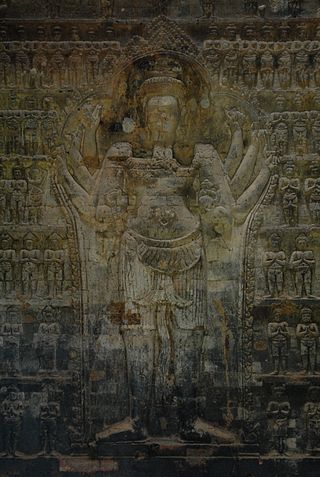Isanavarman may refer to:

Year 928 (CMXXVIII) was a leap year starting on Tuesday of the Julian calendar.
Matilda or Mathilda may refer to:
Khosrow may refer to:

Chenla or Zhenla is the Chinese designation for the successor polity of the kingdom of Funan preceding the Khmer Empire that existed from around the late 6th to the early 9th century in Indochina. The name was still used in the 13th century by the Chinese envoy Zhou Daguan, author of The Customs of Cambodia. It appears on the Mao Kun map. However, modern historiography applies the name exclusively to the period from the late 6th to the early 9th century. This period of Cambodian history is known by historians as the Pre-Angkor period. It is doubted whether Chenla ever existed as a unitary kingdom, or if this is a misconception by Chinese chroniclers. Most modern historians assert that "Chenla" was in fact just a series of loose and temporary confederations of principalities in the pre-Angkor period.
King Fuad, also spelled King Fouad, may refer to two different Kings of Egypt:
Abda may refer to:
King William may refer to:
Yazdegerd, Yazdgerd, Yazdigird, or Yazdagird may refer to:
Ladislaus I may refer to:

The Maukhari dynasty was a post-Gupta dynasty who controlled the vast plains of Ganga-Yamuna for over six generations from their capital at Kanyakubja. Maukharis were Kshatriyas who belonged to the Chandravamsha or the Lunar race. They earlier served as vassals of the Guptas and later of Harsha's Vardhana dynasty. The Maukharis established their independence during the mid 6th century. The dynasty ruled over much of Uttar Pradesh and Magadha. Around 606 CE, a large area of their empire was reconquered by the Later Guptas. According to Hieun-Tsang, the territory may have been lost to King Shashanka of the Gauda Kingdom, who declared independence circa 600CE.
Īshān is an honorific title given to Sufi leaders in Central Asia.
Ladislaus II may refer to:

Ishanavarman II was an Angkorian king who is believed to have ruled from 923 to 928. His empire may have been confined to Angkor and the area around Battambang to the west.

Sambor Prei Kuk (Isanapura) is an archaeological site in Cambodia located in Kampong Thom Province, 30 km (19 mi) north of Kampong Thom, the provincial capital, 176 km (109 mi) east of Angkor and 206 km (128 mi) north of Phnom Penh. The now ruined complex dates back to the Pre-Angkorian Chenla Kingdom, established by king Isanavarman I as central royal sanctuary and capital, known then as "Isanapura". In 2017, Sambor Prei Kuk was declared a UNESCO World Heritage Site.
Ladislaus Jagiello may refer to:
Kiara may refer to:
Īśānavarman or Yīshēnàxiāndài was a king of the kingdom of Chenla in 7th century, which would later become the Khmer Empire. He was the son of, and successor to Mahendravarman.
Ladislaus III may refer to:
Mushika-vamsha is a Sanskrit dynastic chronicle composed in 11th century by poet Atula. It narrates the legendary history of the Mushika dynasty, which ruled the northern part of the present-day Kerala state of India. The chronicle moves from mythological beginnings of the founding ancestors to more authentic genealogical history in later sargas.

Iśanavarman was the first independent Maukhari ruler of Kannauj. He was a very powerful king, and adopted the title of Maharajadhiraja.